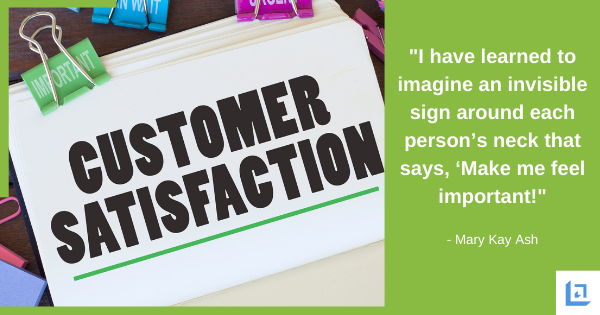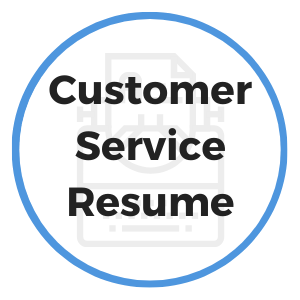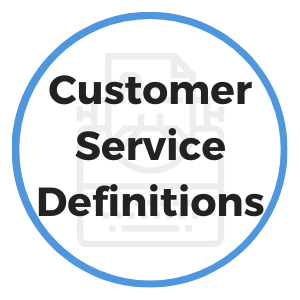- Home
- Customer Service Articles
- Employees Taking Ownership in Customer Service
Employees Taking Ownership In Customer Service
Taking ownership in customer service should be a primary goal for every member of your team. Smart leaders empower their employees with greater decision-making authority related to their role in delivering a quality customer experience. Allow your employees to do what is necessary to take care of their customer, even if this requires a financial cost to the business.
Why? Because excellent customer service will drive increased sales!
Understand this is not a recommendation to abdicate your role as the leader or to allow your employees unlimited authority to spend money. Rather, you are encouraged to expect employees to view their job as if they owned the business; to think and behave as if they are walking in your shoes. Teach employees to start thinking like a business owner so they make decisions that protect the brand and reputations of the business, while doing what's right for the customer.
Most employees will respond to this kind of opportunity with great enthusiasm, and they will make an extra effort not to disappoint. Employees should understand, however, that with more authority comes greater responsibility and increased accountability.
For employees to fully embrace taking ownership in customer service requires management to explain what's in it for them. So, what is in it for the employees? Is it more money; increased incentive pay; higher perceived status in the workplace; greater recognition; increased opportunity for future promotion?
The rewards might be any or all of the above, but whatever carrot(s) you might offer to team members, perhaps the most important is the satisfaction they will feel by being a part of something successful; something larger than ones self; contributing at a higher level and knowing that their personal involvement in owning the customer experience directly increases the value of the entire organization.
"To be the best place to buy, you must be the best place to work. Treat your employees the way you want your customers to be treated–maybe even better!"
- Shep Hyken
Employees who are not interested in taking ownership in customer service delivery may not be in the right role, which can provide an opportunity to reassign and replace with team members who are more suited for the role and the responsibility that goes with it. However, employees who do step up and accept ownership will experience a higher degree of job satisfaction because they know they have earned your trust to do what is right for their customers.
Empowering employees with decision making authority makes for happier employees, which equates to higher employee retention - and that naturally leads to increased customer retention.
How to Position Employees for Taking Ownership in Customer Service Situations
While the goal is to empower employees to take great care of their customers, you need to provide clear limits and process that employees can freely work within. Rules will vary based on the type and size of the business. For example, if you are running a small business that has low margins, you'll want to set spending limits for employees that won't place the business at risk. However, if the business is well established and has solid cash flow, you may feel more comfortable setting higher levels of spending authority for your team members.
Senior level employees might have higher spending limits than their subordinates, which helps to support newer employees who might not be comfortable approving a large refund for a customer. Leaders must think through the appropriate limits and the approval process to support employees taking ownership in customer service.
With limits and process clearly defined, it's time to empower your team members for taking ownership in customer service situations.
Effective leaders will communicate clearly to employees that they should be "taking it personal" when a customer chooses to take their business to a competitor. Everyone in the organization should wince at the very thought of a customer choosing to leave. Team members who are not fully committed to the customer experience may not understand how critical they are in the process. So, let's explain it to them.
Communicate to your employees that you and the company is fortunate because you have the ultimate advantage - something extremely valuable, something no competitor can duplicate... go on to state that this ultimate advantage is so highly prized that you want each employee to understand how much this asset is valued and appreciated.
Next, ask the team if anyone knows what you are referring to as "the ultimate advantage". After a brief pause, simply state "The ultimate advantage we possess, the reason we will outpace our competitors, is because we have YOU. YOU are what give us the ultimate advantage."
The above message, communicated clearly and from the heart, will be well received by each employee. This message is key to help promote employees for taking ownership in customer service situations. When your employees know how much you value and trust them, they will work overtime to meet your customer service expectations.
"No company, small or large, can win over the long run without energized employees who believe in the mission and understand how to achieve it."
- Jack Welch
Examples of Employees Taking Ownership in Customer Service
Employees taking ownership in customer service will be an ongoing, never-ending challenge, but it's worth the time and effort of every great leader because they know the importance of consistently delivering an exceptional customer experience. Leaders recognize that the life of their business depends on great customer service.
As you train employees for taking ownership in customers service, here are some common examples to share:
- Validate the Customer's Issue - in most cases customers will have a legitimate concern, but even when the customer's issue might not pass the credibility test, employees can state with conviction, "I understand what you are saying, and I'll do everything I can to help you with that." This sends a clear message to the customer that the employee is focused and engaged in helping them with their issue. In the end, the employee may or may not be able to fully meet the customer's expectations, but at least the customer won't perceive the employee as being uncaring or dismissive.
- Confirm Best Customer Solution - how many times have you went into a home improvement store to get a part for a project, only to get home and realize it's not exactly what you need, so you have to go back to the store, wait in line to return it, find the correct part, and then wait in another line to make another purchase? When a customer comes into your place of business, take time to ask a couple clarifying questions to ensure that what the customer thinks he needs is actually what he needs. Customers appreciate that extra level of engagement on their behalf and they will remember the time and care you took to ensure they were satisfied with their original purchase.
- Navigate With The Customer - when a customer asks an employee where they can find a certain product, it's easy to point the way and assume the customer will quickly find the product, but employees who are taking ownership in customer service will take it one step further by responding with, "Oh, I know exactly where you can find that, follow me and I'll take you right to it." Upon finding the item, ask the customer a clarifying question or two to ensure that is in fact the right product for them. Also, ask the customer if they have any questions about how to use the product, in short, be of service to the customer in a way they will remember and appreciate.
- Emphasize What You Can Do For The Customer - employees won't be able to grant every customer request. There will be times when a customer is simply being unreasonable and their expectations are unreasonable. Arm your employees with the knowledge that they can respond affirmatively in almost any situations by stating what they can do, rather than focusing on what can't be done. For example, if a customer comes in and requests a full refund on a $200 item they purchased over a year ago, you might respond with, "Oh, I see you made this purchase over a year ago and we can only refund within the first 90 days. I can provide you with a special discount of 20%, which would be $40 off if you'd like to purchase a replacement, or I can provide you with a $25 store service credit for your next purchase. Are you interested in either of those two options?" Arm your people with positive solutions for any difficult scenario.
To ensure you provide team members with the best possible examples on how they can begin taking ownership of customer service, lead a discussion to identify common scenarios that might occur with their customers. These scenarios will be specific to your business and their client base. Invite team members to contribute their own best practices and ideas on how to turn difficult customer interactions into positive outcomes.
Once you are confident that employees are taking ownership in customer service situations, you'll spend less time prospecting and more time welcoming new customers who've been referred by your existing customers.





